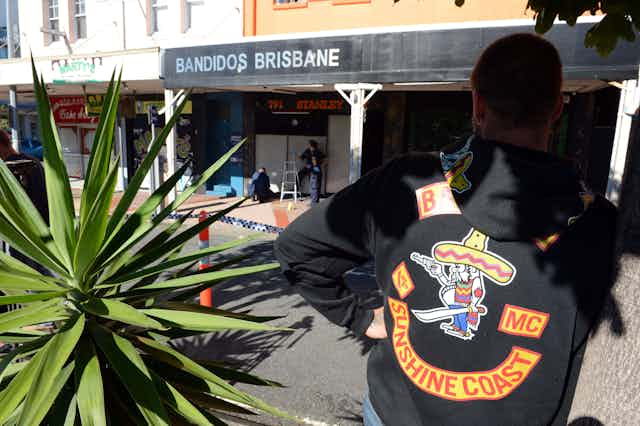The Queensland government has revealed proposed new laws to combat bikies. This is in response to Labor’s election promise to review the former Newman government’s anti-bikie laws. The new legislation proposes to ban the wearing of all gang colours in public, marking an Australian first.
But what will these laws achieve? And is the threat real or perceived?
Are bikies public enemy number one?
Bikie gangs lend themselves to being presented as at the forefront of serious and organised criminal activity throughout Australia. They are easily identifiable to the general public and have committed some brazen displays of public violence.
But in reality, the case against the bikies is often overstated by law enforcement agencies and governments, and pounced on by the media as great copy.
The Queensland Police Service (QPS) claims bikies commit about 0.6% of all crime in the state. The Queensland Taskforce on Organised Crime Legislation said bikies commit less than 1% of overall reported crime. In regard to media portrayals of the bikies, the taskforce noted:
The amplification of the role of OMCGs [outlaw motorcycle gangs] in criminal activity across Queensland has, in the face of the actual statistics, arguably distorted the public’s perception of the actual extent of the threat.
This is illustrated in Right to Information arrest figures I obtained in August 2016. These showed there had been 2,573 people arrested on 8,582 charges since the commencement of the Queensland bikie blitz in October 2013. Yet Mick Niland, the head of the QPS’ anti-bikie taskforce, recently admitted arrests of actual bikies were much lower than that (925 bikies on 3,347 charges since October 2013).
The organised crime taskforce noted that many of those arrests attributed to bikie gangs are in fact not related.
Spreading across Australia
In 2015 Victoria enacted new laws to deal with bikie gangs. South Australia has introduced laws heavily based on Queensland’s existing model, despite their lack of success.
New South Wales already has consorting laws it uses to police bikie gangs. The NSW Ombudsman has conducted two reviews on the use of this legislation – one in 2014 and another in 2016. Both found shortcomings in the way police were using the legislation.
The 2016 review recommended the use of the consorting laws be focused only on serious or organised crime, and prohibited from being used to tackle minor or nuisance offending.
The proposed Queensland law does not necessarily focus on consorting for the purpose of criminal activity. It says:
… the person’s association with the other person need not have a purpose related to criminal activity.
This would seem at odds with the government’s claims that the laws:
… would enable law enforcement agencies to tackle all forms of serious organised crime … by focusing on people’s criminal activity, rather than a focus on any individual group.
Queensland’s new laws draw heavily on the NSW consorting laws. They include several provisions, including consorting offences, a ban on clubhouses, anti-fortification requirements, and public safety orders.
Perhaps most controversially they ban the wearing of gang colours in public. Until now colours had only been banned in licensed venues in some states.
The previous Queensland state government rejected such a move. Then-premier Campbell Newman said:
We don’t go after people because of the clothes they wear, the tattoo they may have, the way their wear their hair. We go after the people who break the law, who are a threat to society.
But banning colours is now seen as a way to combat organised crime.

Police already have the tools they need
The QPS and other Australian law-enforcement agencies already had powerful legislative tools to combat criminal organisations prior to enacting consorting-specific legislation.
Queensland’s Criminal Organisations Act provides for making declarations and control orders for preventing and disrupting the activities of organisations involved in serious criminal activity, and of their members, former members, prospective members and associates.
Ironically, this legislation was introduced by the then-Labor government in 2009, and was opposed by the LNP opposition both before and after its introduction. Its criticisms included:
This bill is a repugnant attack on the rights and liberties of individuals.
The QPS has made only one application under it to have an organised declared a criminal organisation: the Gold Coast chapter of the Finks bikie gang. The application and the legislation successfully withstood a High Court challenge.
At the time, QPS Assistant Commissioner Mike Condon said:
Where there is sufficient evidence we will take action.
Despite this in 2014, the QPS withdrew is application regarding the Finks. The reasons for withdrawal were suppressed. And no other evidence has ever been presented to make an application against any other gang in Queensland.
What will the proposed laws achieve?
It may well be difficult for the minority Labor government in Queensland to have these laws passed. Minor parties and independents have expressed concern with them.
This reflects to some degree a state of policy paralysis the government finds itself in. It has insufficient numbers in parliament to pass legislation without crossbench support.
The devil is in the detail. The government says even if the new laws are passed, the existing laws will remain in place for two years – possibly until after the next state election. This will allow the government to claim it did “something” about the unpopular existing laws, but that by bringing in its own laws it is also tough on crime.
In any case, like those that preceded them, these proposed laws may just end up being window-dressing. Existing offences and investigative powers are more than sufficient to deal with the threat of organised crime and criminal elements in the bikies.

